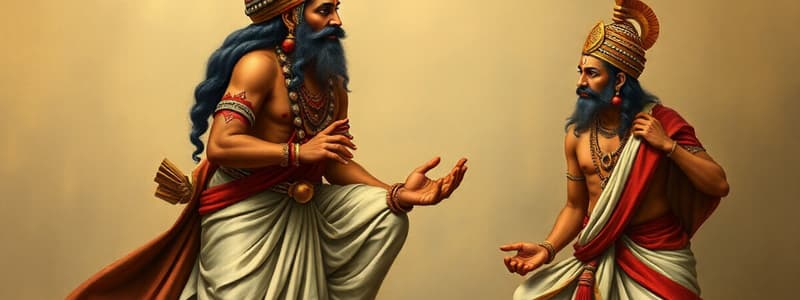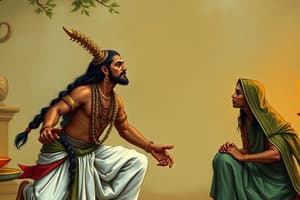Podcast
Questions and Answers
Which of the following options refers to the singular first case form of the word 'Ram'?
Which of the following options refers to the singular first case form of the word 'Ram'?
- राम
- रामानाम्
- रामः (correct)
- रामे
What does the rule 'अर्थवदधातुरप्रत्ययः प्रातिपदिकम्' pertain to?
What does the rule 'अर्थवदधातुरप्रत्ययः प्रातिपदिकम्' pertain to?
- Derivation of adjectives
- Formation of verbal roots and suffixes (correct)
- Formation of compound words
- Usage of conjunctions
Which of the following describes the rule 'औङ् आपः' or 'अतोऽय'?
Which of the following describes the rule 'औङ् आपः' or 'अतोऽय'?
- Describes vowel changes in nominal forms
- Focuses on noun declension rules
- Indicates a transformation of verbs
- Refers to the application of certain suffixes (correct)
Which literary work is associated with Kalidasa that features similes?
Which literary work is associated with Kalidasa that features similes?
What type of work is necessary to write as part of Question 6?
What type of work is necessary to write as part of Question 6?
What is the primary focus of the examination mentioned?
What is the primary focus of the examination mentioned?
What is the maximum marks for this examination?
What is the maximum marks for this examination?
What is the duration of the examination?
What is the duration of the examination?
In which year is this examination taking place?
In which year is this examination taking place?
Which section requires very short answer questions?
Which section requires very short answer questions?
Who is the author of the play Abhijñānaśākuntala?
Who is the author of the play Abhijñānaśākuntala?
What is the name of the jester in Abhijñānaśākuntala?
What is the name of the jester in Abhijñānaśākuntala?
How many acts does the play Svapnavāsavadattam have?
How many acts does the play Svapnavāsavadattam have?
Who is the protagonist of Abhijñānaśākuntala?
Who is the protagonist of Abhijñānaśākuntala?
What is the name of the author who wrote Mrcchakatika?
What is the name of the author who wrote Mrcchakatika?
What is the primary theme explored in the first verse?
What is the primary theme explored in the first verse?
In the second verse, what contrasting elements are highlighted?
In the second verse, what contrasting elements are highlighted?
What literary device is predominantly used in the verses provided?
What literary device is predominantly used in the verses provided?
How does the imagery in the first verse contribute to its overall meaning?
How does the imagery in the first verse contribute to its overall meaning?
What emotional response does the second verse evoke regarding beauty?
What emotional response does the second verse evoke regarding beauty?
What sentiment does the verse primarily convey regarding the beloved?
What sentiment does the verse primarily convey regarding the beloved?
Which aspect of nature is highlighted in the verse?
Which aspect of nature is highlighted in the verse?
What does the verse metaphorically imply about the nature of a daughter?
What does the verse metaphorically imply about the nature of a daughter?
What elements does the verse reference regarding the character's thought process?
What elements does the verse reference regarding the character's thought process?
In relation to the character, what is noted about the changing world?
In relation to the character, what is noted about the changing world?
What literary work involves discussion of aphorisms in its first act?
What literary work involves discussion of aphorisms in its first act?
Which act of Abhijñānaśakuntalam is noted for its key themes?
Which act of Abhijñānaśakuntalam is noted for its key themes?
In Abhijñānaśakuntalam, how do the themes in the fourth act relate?
In Abhijñānaśakuntalam, how do the themes in the fourth act relate?
What is NOT a focus of the first act aphorisms in Swapnavasavadatta?
What is NOT a focus of the first act aphorisms in Swapnavasavadatta?
Which aspect is NOT typically highlighted within the themes of Abhijñānaśakuntalam?
Which aspect is NOT typically highlighted within the themes of Abhijñānaśakuntalam?
Flashcards
First Case Ending: "a"
First Case Ending: "a"
In Sanskrit grammar, the first case ending is used for the subject of a sentence. Singular first case ending for words ending in "am" like Ram is "a"
Third Case Ending: "am"
Third Case Ending: "am"
The third case ending is used for the object of a sentence and is derived by adding "am" to nouns ending in "am". For example, "Ram" becomes "Ramam" in the third case.
Rule: "अर्थवदधातुरप्रत्ययः प्रातिपदिकम्"
Rule: "अर्थवदधातुरप्रत्ययः प्रातिपदिकम्"
This rule in Sanskrit grammar states that a base word remains unaltered even after attaching a suffix, if the suffix does not change the meaning of the base word.
Rule: 'औङ् आपः'
Rule: 'औङ् आपः'
Signup and view all the flashcards
Rule: 'अतोऽय'
Rule: 'अतोऽय'
Signup and view all the flashcards
What is the poetic genre of Abhijñānaśākuntala and who is its author?
What is the poetic genre of Abhijñānaśākuntala and who is its author?
Signup and view all the flashcards
What meter and deity are praised in the invocation of Abhijñānaśākuntala?
What meter and deity are praised in the invocation of Abhijñānaśākuntala?
Signup and view all the flashcards
What is the name of the jester in Abhijñānaśākuntala?
What is the name of the jester in Abhijñānaśākuntala?
Signup and view all the flashcards
Who is the author of Uttarāmacarita and how many acts does it have?
Who is the author of Uttarāmacarita and how many acts does it have?
Signup and view all the flashcards
Who is the protagonist of Abhijñānaśākuntala and what type of protagonist is he ?
Who is the protagonist of Abhijñānaśākuntala and what type of protagonist is he ?
Signup and view all the flashcards
What is the basis of Abhijnanasakuntalam?
What is the basis of Abhijnanasakuntalam?
Signup and view all the flashcards
What type of work is Abhijnanasakuntalam?
What type of work is Abhijnanasakuntalam?
Signup and view all the flashcards
Who are Shakuntala's friends?
Who are Shakuntala's friends?
Signup and view all the flashcards
What is the Mahabharata?
What is the Mahabharata?
Signup and view all the flashcards
Who wrote Abhijnanasakuntalam?
Who wrote Abhijnanasakuntalam?
Signup and view all the flashcards
What are aphorisms and how are they used in Swapnavasavadatta?
What are aphorisms and how are they used in Swapnavasavadatta?
Signup and view all the flashcards
What are the key themes of the fourth act of Abhijñānaśakuntalam?
What are the key themes of the fourth act of Abhijñānaśakuntalam?
Signup and view all the flashcards
Verse Describing Love and Longing
Verse Describing Love and Longing
Signup and view all the flashcards
Verse about a Daughter's Status
Verse about a Daughter's Status
Signup and view all the flashcards
Verse Describing a Character's Thought Process
Verse Describing a Character's Thought Process
Signup and view all the flashcards
Clarify the Meaning of the Verse
Clarify the Meaning of the Verse
Signup and view all the flashcards
Verse about World Changes and a Character
Verse about World Changes and a Character
Signup and view all the flashcards
Verse 1: “न खलु न खलु बाणः सन्निपाव्यो ऽमस्मिन् मृदुनि-मृगशरीरे पुष्पराशाविवाग्निः । क्वबत हरिणकानां जीवितं चातिलोलं क्व च निशित-निपाता वज्रसाराः शरास्ते ।।”
Verse 1: “न खलु न खलु बाणः सन्निपाव्यो ऽमस्मिन् मृदुनि-मृगशरीरे पुष्पराशाविवाग्निः । क्वबत हरिणकानां जीवितं चातिलोलं क्व च निशित-निपाता वज्रसाराः शरास्ते ।।”
Signup and view all the flashcards
Verse 2: "सरसिजमनुविद्धं शैवलेनापि रम्यं मलिनमपि हिमांशोर्लक्ष्म लक्ष्मीं तनोति । इयमधिकमनोज्ञा वल्कलेनापि तन्वी किमिव हि मधुराणां मण्डनं नाकृतीनाम् ।।"
Verse 2: "सरसिजमनुविद्धं शैवलेनापि रम्यं मलिनमपि हिमांशोर्लक्ष्म लक्ष्मीं तनोति । इयमधिकमनोज्ञा वल्कलेनापि तन्वी किमिव हि मधुराणां मण्डनं नाकृतीनाम् ।।"
Signup and view all the flashcards
Study Notes
Shorts
- Exam Paper Code: 3111033/9750
- B.A. (IIInd Year) Semester III, 2022-23
- Sanskrit Natak Evam Vyakaran
- Time: 3 Hours
- Maximum Marks: 75
- Instructions: Answer all questions in 500 words.
Question 6
- Explain the word "राम" and its meaning.
- Find the synonyms and antonyms of "राम" and give examples.
Question 1
- Answer all questions of the paper in 50 words each.
Studying That Suits You
Use AI to generate personalized quizzes and flashcards to suit your learning preferences.
Description
Test your knowledge on the works of Kalidasa and related literary concepts with this quiz. Questions cover themes, characters, and rules of Sanskrit literature, particularly focusing on 'Abhijñānaśākuntala' and 'Mrcchakatika'.




